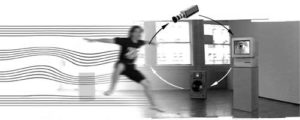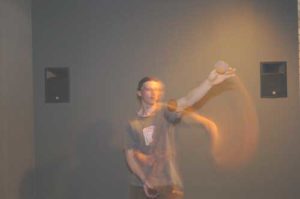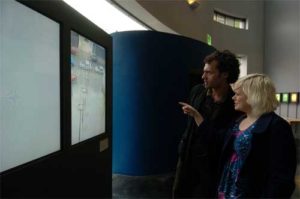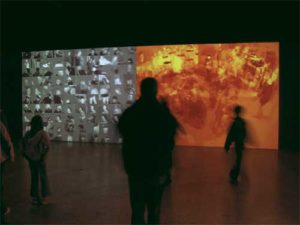



Twisting Fistfuls of Time with David Rokeby
An Interview with David Rokeby, in conjunction with his first UK retrospective Silicon Remembers Carbon, FACT, Liverpool, (20th April – 10th June), by Charlotte Frost.
Part 1. 2nd part of the interview will be published here on 28/05/07.
CF: You describe art galleries where you install your work as laboratories and your installations as a ‘freeform research’. Can you expand on this idea?
DR: I think particularly when you are using new technologies which haven’t been around for a long time, which haven’t been digested by our culture, putting them out in any way – even as a commercial concern – is a research process. As an artist, if you are working with something like paint, then you are dealing with something where the parameters are reasonably well-known and reasonably familiar to all the people who are coming to the gallery. There is less of a possibility of something research-like happening there. With new technology, there is a question I am asking by putting the stuff out there: what’s going to happen? I don’t know what’s going to happen, to a certain degree, so I’m a bit like a natural historian behind a duck blind waiting for the ducks to mate; I can’t make them mate, I’m not sure they are going to mate, and when they mate, I’m not sure how they are going to do it, but I hope my duck-blind is sufficient to make them feel comfortable so that they will do their thing.
That is part of what I do, but in connection with that, what I’m doing when I’m working with technology is looking for those things that I catch out of the corner of my eye (not literally) that are strangely interesting, that I don’t completely grasp and where there seems to be more to it. Or things I see during the course of working on pieces where I just think that people should see this because it would help them to understand some facet of what’s at play in the shifts in society that are happening because of technology.
On the other hand, the pieces are also artworks and there I have to take off the hat of the natural historian and think about what I want to accomplish, but the two are always going to be in play.
CF: It is quite a complete catalogue of your work which will be shown here at FACT. What are you hoping FACT audiences might give to and receive from such a substantial collection?
DR: That’s a good question. Retrospectives are always curious things because you don’t always see your work together like this and I tend to find myself simultaneously impressed by how much I’ve accomplished and on the other hand saying: “Is that all there is? Is that the entire sum quota of my work?” It’s a really mixed experience.
What presenting the range of work would hopefully say to the audience, it’s hard to know. To the seasoned new media viewer, the range might help them see the fairly peculiar perspective I have on new media. For the average viewer I think, from my experience, the response will be more of a pleasure of engagement. The works are mostly pretty approachable but hopefully very layered at the same time but I don’t expect the average FACT gallery viewer to be considering my career so deeply so much as having the experience of the work. Whether they see it as a disparate, random, spray of stuff or whether it coheres for them is an interesting question too. For me, in retrospect now, I can see how all these things are linked, but on first view some of them might seem quite different from the others.
CF: Do you think it might benefit a on-new-media-initiated-audience to see them together? Or is there perhaps – I was reading in something you’d written about Virtual Reality Sickness or what happens when one gets very involved in [url:http://www.rokebyshow.org.uk/VNSystem.html]Very Nervous System[/url] – an element of overload?

DR: I think any extensive show of media that is time-based is potentially an overload because there is a lot of density in each work, but don’t think that is particularly because of the new media side of things. I don’t think any of the works are in this case tuned to be that kind of heartbeat inducing work. I rather suspect from experience that what will happen is that people will have their favourites and ones they just don’t understand why I’ve bothered to do that and a few will hopefully see from the collection of works the peculiar subjective perspective that I have.
CF: Your work is quite popular with science museums – you’ve had permanent pieces at the [url:http://www.sciencemuseum.org.uk/]London Science Museum[/url], [url:http://www.technopolis.be/nl/index.php]Technopolis in Belgium[/url] and the [url:http://www.ontariosciencecentre.ca/]Ontario Science Centre[/url] – but this exhibition at FACT is your first major art show in the UK. Why do you think this is? And does it bother you?
DR: I don’t really know why exactly. Its always been a question. I’ve had presence in the UK: I’ve given lectures and had the Science Museum show and couple of other shows, but I’m not sure why. Does it distress me? No, not particularly. Its really lovely to finally have been invited to do a really substantial show and to do it in a place that really puts on strong shows.
My career wanders from country to country; its kind of a nomadic career. I did a lot of work in France in the late 1980s, in Germany in the early 1990s, there was an Austrian phase in the late 1990s and then I showed a lot in Italy and Mexico. Right now, most of the work I am doing is actually in Canada, which is strange for me because after getting out of art school I didn’t show in Canada very much. Now I’m showing in Canada a lot, it just indicates the odd transit of my career. So the fact that it comes and goes, or came and went, or did or didn’t happen in the UK is part of that.
I still haven’t shown in Iceland!
CF: Is important that audiences understand the complex level of technology that goes into your work? Clearly you have to and you produce a lot of the coding, for example, yourself, but do you think there is some sort of technological education that’s up for grabs in the pieces or are they really just about setting up that immediate engagement and highlighting the ubiquity of technology today?
DR: I don’t think its important at the first level that people understand any of the technology that’s involved in the works. I think each of the pieces functions satisfyingly on a purely experiential level. That being said, a number of the works do inevitably refer to or comment on technology. Sometimes I think the pieces are trying to help people understand what technology is and isn’t capable of so partly there is an educational thing there – not so much about how something works, but more about the texture and quality of the way it functions. Someone who comes in with a strong programming knowledge is going to take something different from the pieces than someone with no technical skills at all. What I try to do is create supplementary levels so that the work starts addressing you as a human being – that’s the first level of address – and it will address other levels if you are open to them.
CF: Much of your output still stems from Very Nervous System, can you talk me through some of the various different incarnations of Very Nervous System and describe their differing potentials?

DR: Very Nervous System evolved over about ten years. Since the early 1990s I kept generalising and generalising the code that was used for it and it has turned into a very rich toolset predominantly for dealing with live video. That toolset has become almost like a pallet and brush for me; I know it really well and it was designed by me to reflect the things that I’m interested in, to give me the kind of options that I’m interested in pursuing. So I feel like I can gesture with it pretty effectively and so it’s a very compelling tool for me to use to create new work.
The first period of Very Nervous System was about interactive sound installations where body movement was translated into sound. The next big step was in 1995 because the system had been analysing images but it hadn’t been showing the images it was analysing. In 1995 I finally found a way to take information that was being calculated by Very Nervous System and externalise it as video signal so that I could see some of the inner workings. That turned it almost instantly into a new piece called [url:http://www.rokebyshow.org.uk/watch.html]Watch[/url]. It simply took two internal images from Very Nervous System and externalised them – and then I dolled it up a bit to be as effective as I thought it could be – but basically it shows what’s moving and what’s still in two separate images – the still is not a purely still shot but its like an evolving long exposure where anything that is moving is blurred, its only showing what’s not moving – bricks, mortar – everything else is gone.

Then I started to build and expand the tools on two sides – the tools for tracking in video (usually people) and tools for building and working with video. So the next thing was Watched and Measured for the Science Museum. That went deeper into the surveillance side of things and I got into tracking people’s heads and following them around and collecting images. So there has been a continuing path of Very Nervous System-derived surveillance installations including Seen which will be shown here, which was commissioned for the Venice Biennale of Architecture in 2002, and [url:http://www.rokebyshow.org.uk/taken.html]Taken[/url], which was also produced later that year and is also in the show here.

Just before that there was a new direction with a piece called Machine for Taking Time which is a different type of surveillance piece which records a thousand of images a day from different pan-tilt positions and builds up a large database of images which it can then stitch together in new ways. That’s again using the software but moving away from the core. It has become quite a generalised set of tools.
CF: You’ve mentioned using time as a raw material and I’m wondering what types of time have you worked with in the pieces you have on show in this retrospective; if time is just an essential ingredient in all art and whether it is possible to make art that doesn’t have time as a key material?
DR: It would be an interesting challenge to try to come up with a work that didn’t in some way involve time – it would probably be impossible which would make it an interesting challenge!
I think for me what has been special about my relationship with time has not been so much doing time-based work as being able, through the technology, to mould and shape time almost as a plastic material. You can say that a composer is always working with time, placing notes in time, I have not been placing notes in time, but rather creating the possibilities for things to happen. This places things in time, but doesn’t say where in time they are going to be – so there is a second level of abstraction that happens. In writing pieces for Very Nervous System I often felt like I was grabbing fistfuls of time and twisting it.
On another level, time is an explicit theme in a lot of my work – separate from the fact I’m also playing with it. I’ve been fascinated with time since I was about ten or eleven, and then in high school I tried to imagine the fourth dimension and things across time and the shape they would have and basically what the world would look like as a four-dimensional experience. When I was at art school I think I pushed my brain into all sorts of situations and at one time I felt like I could actually see things across time, I could see the past and the future and the present of a car moving in front of me like it was a continuum. And it was maybe twenty years later that I realised actually realised this in Watch – I had created what I had seen before – so I’ve had a very long dialogue with time.
In terms of the different kinds of time, the computer can only deal with time in a very arbitrary way but the audience will experience it depending upon what is the content of the work and how it is portrayed. So although I’m always working with time in a similar way, I think the ways in which the pieces reflect upon time are quite different. Actually, I haven’t really thought about cataloguing the ways I’ve referred to time! In most of the surveillance pieces its about experiential time. In Machine for Taking Time it is partly about the unfolding of the seasons, but it is also about your experience of time as the viewer and then what happens because you are seeing different time-periods flipping back and forth. You’re experiencing shifts in image but with a coherent framework of the building that was always there every time it was recording, and as those different versions of the same image shift from one to another there is a strange mixture of the sense – almost a shimmering sense – of time and timelessness, so that you feel both a particular moment – the snow that day, the rain this day, the person standing there this day – and on the other hand you feel the almost platonic, abstract form of the garden shed, the bench which never changes!
You might say that what I do with these technologies is take different aspects of time that you couldn’t normally experience and push them into a space where they can be perceived.
CF: Some critics have claimed that despite initially championing interactivity, your more recent works – where unwitting surveillance plays a part – show a more critical stance. Is this true or do you think all your pieces work-thorough the pros and cons of technologies and interactivity, or do they come down on either side?
DR: I think it depends on the year or the day that you talk to me. Certainly at the beginning in the 1980s with Very Nervous System there was at least initially a pretty euphoric, utopian view on interactivity as a good thing that would rescue us from ourselves. As the hype-machines built-up around interactivity in the late 1980s and as it went from being something that a small number of people were doing on their own into something that involved a whole industry it became impossible to maintain that utopian stance. I had the chance over six or seven years in the 1980s to see hundreds of thousands of people interacting with Very Nervous System and seeing both delightful and positive sides of that and seeing really negative things so it was inevitable that I would find myself striking a more critical stance.
I still love the thing that I first loved about Very Nervous System, but I can’t deny that a lot of strange and somewhat disturbing things have been uncovered by watching people with it. Its not really down to interactivity, it comes down to a larger shift. I was nineteen or twenty then, I’m forty-six now. I’ve seen a lot in the past twenty-five years and largely, one of the things that you see, and something that I was disappointed by, was the degree to which people got disappointed by life and got to the point that they were not really interested in getting to the bottom of things or really understanding things, and by how much they became seduced and satisfied by surface. My disaffection with interactivity parallels my learning that people are people. For interactivity to function in the utopian mode I was envisaging in the 1980s requires a willingness to really accept responsibility for the consequences of one’s actions, to struggle to learn new languages (for the computer, or of gesture, or whatever), to learn a new openness, which is not always possible even in the best of situations. In this more compromised world – my new vision of the world as compromised that is – the potentials, the energy, the power of interactivity can easily flip from a positive to real negative.
There were other factors though. It became clear after the first four or five years that the intense interactivity of Very Nervous System made me a lot of fans, but didn’t take as many viewers as I would have liked deeper into the question that the piece was asking. It was as though the piece was so exciting for people that if failed on a certain level and the work had to become a little less exciting if it was to communicate the things that I was wanting it to communicate.
Also as an audience for interactive art developed, it came to establish certain formulas of interactive behaviour, of interactive relationships, that were accepted and reinforced which, though not invalid as such, became restrictive. You might say that one of the reasons I got into this field was because it was wide-open, and there is something about wide-open empty spaces that I like, but as it filled up and became more formulaic I found it restricting. When I show a work like [url:http://www.rokebyshow.org.uk/nChant.html]n-cha(n)t[/url], which has seven computers which are intercommunicating and interacting intensively with each other and may allow you to interact with them, it cuts against so many of the archetypes of what we understand conventionally as interactivity that it really just pisses some people off. But it allows, I think, for a range of expression and possibility that is far beyond the simplistic metaphor for interactivity.
I’ve been involved in interactivity for so long that I guess its inevitable that it would be a big thorny mess in my brain by now.
End of first part of interview.
Visit Part 2